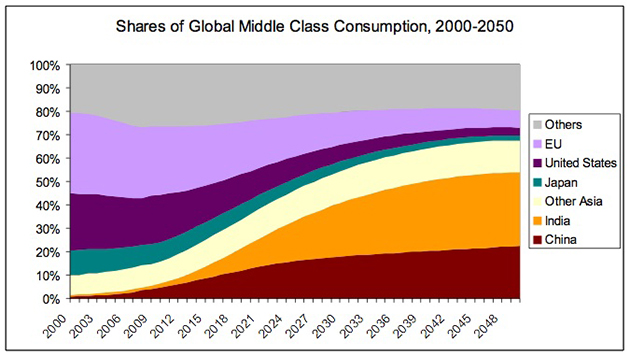
If you were to believe the miserablists of the green-left, the world is locked into a spiralling cycle of Dickensian poverty, with the “One Percent” feasting at the head of the table while 7 billion Olivers pathetically beg for more. In fact, almost the reverse is true: quietly, without fuss, poverty is being practically eliminated. More importantly, the world is about to hit an important tipping-point. Now, the left normally love a good tipping-point, but somehow I suspect this one is going to leave them bitterly disappointed. Quote:
Something of enormous global significance is happening almost without notice. For the first time since agriculture-based civilization began 10,000 years ago, the majority of humankind is no longer poor or vulnerable to falling into poverty. By our calculations, as of this month, just over 50 percent of the world’s population, or some 3.8 billion people, live in households with enough discretionary expenditure to be considered “middle class” or “rich.”
About the same number of people are living in households that are poor or vulnerable to poverty. So September 2018 marks a global tipping point. After this, for the first time ever, the poor and vulnerable will no longer be a majority in the world. Barring some unfortunate global economic setback, this marks the start of a new era of a middle-class majority. End of quote.
Naturally, codifying “middle class” isn’t easy. What’s middle-class in Australia and New Zealand is not going to be the same as, say, India, let alone Britain, where “middle-class” is as much a social as an economic classification. Nonetheless, working definitions of many phenomena are possible, even if they lead to answers that aren’t going to make some people happy. Quote:
We make these claims based on a classification of households into those in extreme poverty (households spending below $1.90 per person per day) and those in the middle class (households spending $11-110 per day per person in 2011 purchasing power parity, or PPP). Two other groups round out our classification: vulnerable households fall between those in poverty and the middle class; and those who are at the top of the distribution who are classified as “rich.”
Our “middle class” classification was first developed in 2010 and has been used by many researchers. While acknowledging that the middle class does not have a precise definition that can be globally applied, the threshold we use in this work has the following characteristics: those in the middle class have some discretionary income that can be used to buy consumer durables like motorcycles, refrigerators, or washing machines. They can afford to go to movies or indulge in other forms of entertainment. They may take vacations. And they are reasonably confident that they and their family can weather an economic shock—like illness or a spell of unemployment—without falling back into extreme poverty. End of quote.
So, why is this “middle-class tipping point” important? Shouldn’t we care more about the poor than the bad ol’ bourgeoisie? Quote:
Because the middle class drive demand in the global economy and because the middle class are far more demanding of their governments.
…The rich spend more per person, but are too few in number to drive the global economy. The poor and vulnerable are numerous, but have too little income to spend…The new middle class is predominantly Asian—almost nine in 10 of the next billion middle-class consumers will be Asian—but they are spread out in China, India, and South and South East Asia. End of quote.
The middle-class are also the economic powerhouse. Quote:
The middle class is already the largest segment of demand in the global economy…it is also the most rapidly growing segment…
…In most countries, there is a clear relationship between the fate of the middle class and the happiness of the population. According to the Gallup World Poll, new entrants into the middle class are noticeably happier than those stuck in poverty or in vulnerable households. Conversely, individuals in countries where the middle class is shrinking report greater degrees of personal stress. The middle class also puts pressure on governments to perform better. End of quote.
brookings.edu
A strong middle-class is key to political stability as well as economic success. The West’s shrinking middle-class does much to explain fracturing polities in the region, while China’s rising middle-class buys its authoritarian regime a degree of invulnerability. Even Marx recognised that the bourgeoisie were a buffer against his ever-hoped-for revolutions.
So, if you’re thinking that the left will celebrate the virtual eradication of poverty and the advent of a middle-class world, think again.

